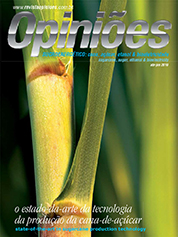Arnaldo José Raizer
Variety R&D Coordinator of CTC
Op-AA-24
The CTC and the sugarcane breeding
CTC, the Sugarcane Technology Center, recently commemorated the 40th. anniversary of its breeding program, which was born of an entrepreneurial vision of the founding of a sugarcane technological development center. In all these years, investments were made in more productive varieties, better adapted and more resistant, as a consequence of the pioneer efforts, determination - and work of a great number of developers.
The initial step was taken by scientists of several countries in cooperation with researchers of Brazil, implementing germ plasma for future hybridization. The first genitors of the future varieties SP and CTC were planted in 1969, in Camamu, State of Bahia, comprising ancestral sugarcane species and foreign varieties. Over time, new introductions took place and genotypes adapted to the national sugarcane environment were formed.
The CTC manages a complete germ plasma bank, currently containing 6,000 genotypes, considered the largest and most diversified in the world, representing a genetic reserve of global importance for the sugarcane culture. As the result of the initial commercial releases in the 1980’s, the national cultivars started occupying increasingly more sugarcane plantation areas.
How-ever, the industry was faced with new challenges and researchers were called to develop even better varieties. Some of the agricultural and industrial benchmarks were: payment for saccharose content, high flowering rate in cultivated varieties, occurrence of important diseases such as the culmicolous smut, brown rust and leaf yellowing, increase in the incidence of the borer, the hopper, the weevil, and others.
In the 1990’s, biotechnology and its tools for breeding based on the sugarcane genome appeared. Economic changes and the sugarcane industry’s deregulation required higher productivity and lower production costs. In other words, more agricultural and industrial efficiency were now expected of the energy mill in the field, which consists of the sugarcane varieties.
In the past ten years, the expansion into more restrictive areas, with poorer soils and in dryer regions, began, crushing was anticipated to start already in March, planting was taking place practically throughout the year, and new diseases and pests appeared. New agronomic techniques, new inputs, the use of irrigation, fertilizer and residues began being economically evaluated.
Mechanization, from planting to harvesting, and the green sugarcane system changed the variety profile, plants were now expected to be more uniform, erect and rich, germinate well and fast, and ratoons now had to support machine traffic. Mills required more energy generation, raw material biomass surpluses were being transformed into renewable energy. Sugarcane variety, the basis of the production chain, must now respond well to these new production environments.
Again research played a fundamental role: genetic breeding programs, new agricultural practices and new cutting, loading and transportation modes, and even industrial processes. If in the past Brazilian research generated technology that supported the industry’s growth, nowadays technologies that seek solutions for challenges identified in agro-industrial practice are created, aimed at the production of food and energy in a sustainable manner.
New hybridizations and genitors, new selection criteria and lines of research are developed in CTC. One looks for precociousness, tolerance to dryness, rusticity, increase in biomass, production of energy, expansion of the genetic base, assessment of transgenic organisms and the use of molecular markers. Under its new operational system, CTC developed 20 new sugarcane varieties, with the denominations CTC1 to CTC20. These new varieties represent the state-of-the-art in varietal development and are increasingly occupying space in associated members. In the past five harvests, planting doubled each year.
For 2010, one predicts that 28% of the plantations will be made using the CTC variety. Our expectation is that in the next few years these varieties will be cultivated in 40% of the Brazilian agricultural area, upholding the current annual productivity gain rate of 3%. Initially focused on the State of São Paulo, in the past seven years - CTC undertook a major decentralization of its breeding program, with the creation of 13 regional centers, to the extent of one center per associated member.
With a representative experimental network, the experience of its developers and the participation of associated technical teams, we produced a varied and profita-ble genetic portfolio. Research and technology transfer teams working together can offer better adapted varieties. Projects for the production of seedlings and planning and variety recommendation tools point to the best sugarcane variety for each associated member and for each production environment, while minimizing losses resulting from improperly performed plantings. In coming years, CTC varieties will become increasingly more specific for each agricultural undertaking, with the intent of obtaining maximum performance of plant, soil, climate, agricultural management and industrial efficiency.




